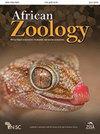适应干旱的副翼足桡足类有助于调节蚊子
IF 0.5
4区 生物学
Q4 ZOOLOGY
引用次数: 1
摘要
我们写这篇文章是为了描述类桡足类在水生环境中调节蚊子幼虫种群的捕食潜力。蚊子传播的疾病继续导致无与伦比的人类发病率和死亡率(Ferguson 2018),并直接威胁到其他野生动物(George等人,2015)。这种疾病负担最集中在撒哈拉以南非洲,蚊子利用的水生栖息地往往是暂时的,在自然条件下,其特点是适应干旱的生态群落。这些群落可能富含捕食者,有助于调节水生幼虫蚊子种群,从而在景观尺度上调节疾病的成年媒介。一种新描述的南部非洲桡足类物种,Lovenula raynerae Suárez-Morales,Wasserman和Dalu 2015(Paradapdominae)(图1),已被确定为一种有效的捕食者,用于在临时水生环境中自然调节医学上重要的蚊子种群(Cuthbert等人,2018)。从视频分析中可以看出(见补充材料视频1),该物种的蚊子致死率似乎甚至受到浪费性消费的支持,即幼虫蚊子被杀死并被部分吃掉,或者根本没有吃掉。此外,对南非东开普省(Paradaptomus sheeltus Sars 1895)(Cuthbert等人,2020和这些作者正在进行的工作)和博茨瓦纳中部地区(Lovenula faliffera Lovén 1845)(Buxton等人,2020b)的其他准底辟动物的新生态评估显示,蚊子控制模式相似。类桡足类,如副底辟类,通常被认为不会消耗蚊子,因此没有生物控制潜力(Marten和Reid,2007年)。然而,副底虫的捕食效率和在非洲的广泛分布(Rayner等人,2001)表明,该底虫亚科对蚊子的控制有着广泛的贡献。准底辟动物大多为非洲特有物种,适合在临时湿地生活。作为临时湿地专家,它们产生的抗旱卵在降雨事件后迅速孵化和发育,使捕食者种群能够快速发育(Wasserman等人,2018),进而增强病媒调节潜力。然而,除了最近在南部非洲进行的研究外,对这一广泛分布的群体所做的生态学工作很少(见Bird等人2019及其参考文献;Cuthbert等人2020)。尽管最近的研究重点是控制库蚊属,但对其他蚊子属(如伊蚊和按蚊)也可能有类似的效果,但需要进一步研究。了解关键分类群提供的生态系统服务对于有效的环境管理至关重要。我们认为,准滞虫提供了广泛的天然蚊子生物防治服务,这是Letter本文章由计算机程序翻译,如有差异,请以英文原文为准。
Arid-Adapted Paradiaptomid Copepods Contribute to Mosquito Regulation
We are writing to describe the predatory potential of calanoid copepods for the regulation of mosquito larval populations in aquatic environments. Mosquito-borne diseases continue to drive unparalleled human morbidity and mortality (Ferguson 2018), and directly threaten other wildlife (George et al. 2015). This disease burden is most concentrated in Sub-Saharan Africa, where aquatic habitats exploited by mosquitoes are often temporary and, under natural conditions, characterised by arid-adapted ecological communities. These communities can be predator rich, contributing to the regulation of aquatic larval mosquito populations and therefore the adult vectors of the diseases at the landscape scale. A newly described southern African copepod species, Lovenula raynerae Suárez-Morales, Wasserman and Dalu 2015 (Paradiaptominae) (Figure 1), has been identified as an efficacious predatory agent for the natural regulation of medically important mosquito populations in temporary aquatic environments (Cuthbert et al. 2018). Evidenced from video analyses (see supplementary material video 1), the mosquito killing rates by this species even seem to be bolstered by wasteful consumption, where larval mosquitoes are killed and partially consumed, or not consumed at all. Furthermore, novel ecological assessments of other paradiaptomids in the Eastern Cape Province of South Africa (Paradiaptomus lamellatus Sars 1895) (Cuthbert et al. 2020 and ongoing work by these authors) and Central District of Botswana (Lovenula falcifera Lovén 1845) (Buxton et al. 2020b) have shown similar patterns for mosquito control. Calanoid copepods, such as paradiaptomids, have classically been thought to not consume mosquitoes and thus offer no biocontrol potential (Marten and Reid 2007). However, the predatory efficiency and extensive distribution of paradiaptomids in Africa (Rayner et al. 2001) suggests widespread contributions to mosquito control by this diaptomid subfamily. The paradiaptomids are mostly endemic to Africa and are adapted to life in temporary wetlands. As temporary wetland specialists, they produce drought-resistant eggs that rapidly hatch and develop following rainfall events, enabling predator populations to develop quickly (Wasserman et al. 2018), in turn enhancing disease vector regulation potential. However, very little ecological work has been done on this widespread group, apart from recent studies in southern Africa (see Bird et al. 2019 and references therein; Cuthbert et al. 2020). Although this recent research has focused on control of Culex spp., similar efficacies against other mosquito genera (e.g. Aedes and Anopheles) are likely, but require further investigation. Understanding ecosystem services provided by key taxonomic groups is essential for effective environmental management. We posit that the paradiaptomids provide widespread natural mosquito biocontrol services that are Letter
求助全文
通过发布文献求助,成功后即可免费获取论文全文。
去求助
来源期刊

African Zoology
生物-动物学
CiteScore
2.60
自引率
9.10%
发文量
18
审稿时长
>12 weeks
期刊介绍:
African Zoology , a peer-reviewed research journal, publishes original scientific contributions and critical reviews that focus principally on African fauna in terrestrial, freshwater, and marine ecosystems. Research from other regions that advances practical and theoretical aspects of zoology will be considered. Rigorous question-driven research in all aspects of zoology will take precedence over descriptive research. The Journal publishes full-length papers, critical reviews, short communications, letters to the editors as well as book reviews. Contributions based on purely observational, descriptive or anecdotal data will not be considered.
The Journal is produced by NISC in association with the Zoological Society of South Africa (ZSSA). Acceptance of papers is the responsibility of the Editors-in-Chief in consultation with the Editors and members of the Editorial Advisory Board. All views expressed are those of the author and not necessarily those of the Editors or the Department.
 求助内容:
求助内容: 应助结果提醒方式:
应助结果提醒方式:


